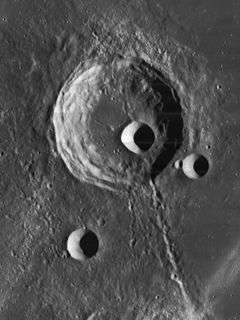Krafft (crater)
Krafft is a prominent lunar impact crater located near the western edge of the Oceanus Procellarum. To the north is the lava-flooded walled plain Eddington. Almost due south is the crater Cardanus, and the two are connected by a 60-kilometer-long chain of craters known as the Catena Krafft.
 Lunar Orbiter 4 image | |
| Coordinates | 16.6°N 72.6°W |
|---|---|
| Diameter | 51 km |
| Depth | 2.0 km |
| Colongitude | 73° at sunrise |
| Eponym | Wolfgang L. Krafft |
Krafft has a sharp, circular rim with a rampart on the exterior, and no central peak. There are several associated craters near the southern rim that are notable for their size in relation to the dimensions of Krafft.
Satellite craters
By convention these features are identified on lunar maps by placing the letter on the side of the crater midpoint that is closest to Krafft.
| Krafft | Latitude | Longitude | Diameter |
|---|---|---|---|
| C | 16.4° N | 72.3° W | 13 km |
| D | 15.1° N | 73.3° W | 12 km |
| E | 15.9° N | 71.7° W | 10 km |
| H | 17.0° N | 77.8° W | 15 km |
| K | 16.5° N | 74.5° W | 11 km |
| L | 16.0° N | 76.3° W | 20 km |
| M | 17.8° N | 75.5° W | 10 km |
| U | 17.2° N | 64.7° W | 3 km |
gollark: What if I add a single comparator?
gollark: Vanilla blocks in this screenshot: that grass, and those torches.
gollark: Nearly 100% free of pesky vanilla blocks.
gollark: Quarrying!
gollark: Now I need a cake. Somehow.
References
- Andersson, L. E.; Whitaker, E. A. (1982). NASA Catalogue of Lunar Nomenclature. NASA RP-1097.CS1 maint: ref=harv (link)
- Blue, Jennifer (July 25, 2007). "Gazetteer of Planetary Nomenclature". USGS. Retrieved 2007-08-05.CS1 maint: ref=harv (link)
- Bussey, B.; Spudis, P. (2004). The Clementine Atlas of the Moon. New York: Cambridge University Press. ISBN 978-0-521-81528-4.CS1 maint: ref=harv (link)
- Cocks, Elijah E.; Cocks, Josiah C. (1995). Who's Who on the Moon: A Biographical Dictionary of Lunar Nomenclature. Tudor Publishers. ISBN 978-0-936389-27-1.CS1 maint: ref=harv (link)
- McDowell, Jonathan (July 15, 2007). "Lunar Nomenclature". Jonathan's Space Report. Retrieved 2007-10-24.CS1 maint: ref=harv (link)
- Menzel, D. H.; Minnaert, M.; Levin, B.; Dollfus, A.; Bell, B. (1971). "Report on Lunar Nomenclature by the Working Group of Commission 17 of the IAU". Space Science Reviews. 12 (2): 136–186. Bibcode:1971SSRv...12..136M. doi:10.1007/BF00171763.CS1 maint: ref=harv (link)
- Moore, Patrick (2001). On the Moon. Sterling Publishing Co. ISBN 978-0-304-35469-6.CS1 maint: ref=harv (link)
- Price, Fred W. (1988). The Moon Observer's Handbook. Cambridge University Press. ISBN 978-0-521-33500-3.CS1 maint: ref=harv (link)
- Rükl, Antonín (1990). Atlas of the Moon. Kalmbach Books. ISBN 978-0-913135-17-4.CS1 maint: ref=harv (link)
- Webb, Rev. T. W. (1962). Celestial Objects for Common Telescopes (6th revised ed.). Dover. ISBN 978-0-486-20917-3.CS1 maint: ref=harv (link)
- Whitaker, Ewen A. (1999). Mapping and Naming the Moon. Cambridge University Press. ISBN 978-0-521-62248-6.CS1 maint: ref=harv (link)
- Wlasuk, Peter T. (2000). Observing the Moon. Springer. ISBN 978-1-85233-193-1.CS1 maint: ref=harv (link)
This article is issued from Wikipedia. The text is licensed under Creative Commons - Attribution - Sharealike. Additional terms may apply for the media files.
